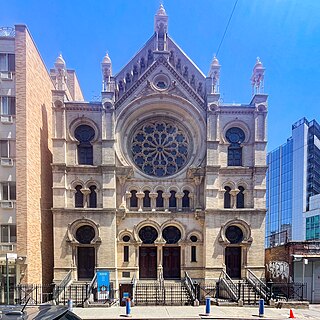
The Eldridge Street Synagogue is an Orthodox Jewish synagogue at 12–16 Eldridge Street in the Chinatown and Lower East Side neighborhoods of Manhattan in New York City. Built in 1887 for Congregation Kahal Adath Jeshurun, the synagogue is one of the first erected in the U.S. by Eastern European Jews. The congregation, officially known as Kahal Adath Jeshurun with Anshe Lubz, still owns the synagogue and hosts weekly services there in the 21st century. The Museum at Eldridge Street, founded in 1986 as the Eldridge Street Project, also occupies the synagogue under a long-term lease. The building is a National Historic Landmark and a New York City designated landmark.

Congregation Beth Israel is a Reform Jewish congregation and synagogue located at 701 Farmington Avenue, in West Hartford, Connecticut, in the United States.

Moorish Revival or Neo-Moorish is one of the exotic revival architectural styles that were adopted by architects of Europe and the Americas in the wake of Romanticist Orientalism. It reached the height of its popularity after the mid-19th century, part of a widening vocabulary of articulated decorative ornament drawn from historical sources beyond familiar classical and Gothic modes. Neo-Moorish architecture drew on elements from classic Moorish architecture and, as a result, from the wider Islamic architecture.

Beth Hamedrash Hagodol is an Orthodox Jewish congregation that for over 120 years was located in a historic building at 60–64 Norfolk Street between Grand and Broome Streets in the Lower East Side neighborhood of Manhattan, New York City. It was the first Eastern European congregation founded in New York City and the oldest Russian Jewish Orthodox congregation in the United States.

The United Hebrews of Ocala is an historic former Reform Jewish synagogue building located at 729 N.E. 2nd Street, in the Tuscawilla Park Historic District of Ocala, Marion County, Florida, in the United States.

Kahal Kadosh Beth Elohim is a Reform Jewish congregation and synagogue located in Charleston, South Carolina, in the United States.

Temple Sinai, also known as Congregation Sinai, whose official name is the Sumter Society of Israelites, is an historic Reform Jewish congregation and synagogue, located at 11-13 Church Street, on the corner of West Hampton Avenue, in Sumter, South Carolina, in the United States.

Congregation Beth Israel is a Reform Jewish congregation and synagogue, located at 1931 NW Flanders Street, Portland, Oregon, in the United States.

Temple Beth-El, officially known as the Congregation Sons of Israel and David, Temple Beth-El, is a Reform Jewish synagogue located at 70 Orchard Avenue, in Providence, Rhode Island, in the United States.

Beth Israel Synagogue is a historic former Jewish synagogue building at 238 Columbia Street in Cambridge, Middlesex County, Massachusetts, in the United States. Built in 1903, it was the first and principal synagogue to serve the East Cambridge area, and is a fine local example of Romanesque Revival architecture. Now converted into residential condominiums, it was listed on the National Register of Historic Places in 1982.

Ahavath Beth Israel, officially Congregation Ahavath Beth Israel, is a Reform Jewish congregation and synagogue, located at 11 North Latah Street, in Boise, Idaho, in the United States. Its 1896 building is amongst the oldest synagogues in continuous use west of the Mississippi River. The congregation is affiliated with the Union for Reform Judaism.

Oheb Shalom Congregation is an egalitarian, Conservative Jewish congregation and synagogue located in South Orange, Essex County, New Jersey, in the United States. The synagogue is affiliated with the United Synagogue of Conservative Judaism.

Temple Beth Israel, sometimes called Charter Oak Temple, is an historic former Reform Jewish synagogue and later church building, now cultural center, located at 21 Charter Oak Avenue, in Hartford, Connecticut, in the United States.

Temple Beth Israel is an historic former Orthodox and Conservative Jewish synagogue building, located at 39 Killingly Drive in the Danielson village of Killingly, Connecticut, in the United States.

Beth Hamedrash Hagodol Synagogue is an historic former Orthodox Jewish congregation and synagogue, located at 370 Garden Street, Hartford, Connecticut, in the United States.

Ahavas Shalom Reform Temple ) is an historic former Reform Jewish synagogue building located at 503 Main Street, in Ligonier, Noble County, Indiana, in the United States.

The Old Beth Israel Synagogue is a former Orthodox Jewish synagogue located at 307 Townes Street in the Stone Avenue neighborhood of Greenville, South Carolina, in the United States.





















